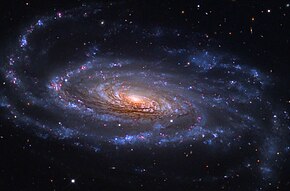| NGC 5033 | |
|---|---|
 | |
| Observation data (J2000 epoch) | |
| Constellation | Canes Venatici [1] |
| Right ascension | 13h 13m 27.5s [2] |
| Declination | +36° 35′ 38″ [2] |
| Redshift | 875 ± 1 km/s [2] |
| Apparent magnitude (V) | 10.8 [2] |
| Characteristics | |
| Type | SA(s)c [2] |
| Size | ~180,000 ly (55.09 kpc) (estimated) [2] |
| Apparent size (V) | 10.7′ × 5.0′ [2] |
| Other designations | |
| UGC 8307, [2] PGC 45948 [2] | |
NGC 5033 is an inclined spiral galaxy located in the constellation Canes Venatici. Distance estimates vary from between 38 and 60 million light years from the Milky Way. The galaxy has a very bright nucleus and a relatively faint disk. Significant warping is visible in the southern half of the disk. The galaxy's relatively large angular size and relatively high surface brightness make it an object that can be viewed and imaged by amateur astronomers. The galaxy's location relatively near Earth and its active galactic nucleus make it a commonly studied object for professional astronomers.
